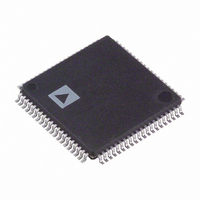ADV7184BSTZ Analog Devices Inc, ADV7184BSTZ Datasheet - Page 40

ADV7184BSTZ
Manufacturer Part Number
ADV7184BSTZ
Description
IC DECODER VID SDTV MULTI 80LQFP
Manufacturer
Analog Devices Inc
Type
Video Decoderr
Specifications of ADV7184BSTZ
Applications
Projectors, Recorders, Security
Voltage - Supply, Analog
3.15 V ~ 3.45 V
Voltage - Supply, Digital
1.65 V ~ 2 V
Mounting Type
Surface Mount
Package / Case
80-LQFP
Resolution (bits)
10bit
Adc Sample Rate
54MSPS
Power Dissipation Pd
550mW
No. Of Input Channels
12
Supply Voltage Range
1.65V To 2V, 3V To 3.6V
Operating Temperature Range
-40°C To +85°C
Tv /
RoHS Compliant
Input Format
Analogue
Output Format
Digital
Rohs Compliant
Yes
Lead Free Status / RoHS Status
Lead free / RoHS Compliant
Available stocks
Company
Part Number
Manufacturer
Quantity
Price
Company:
Part Number:
ADV7184BSTZ
Manufacturer:
Analog Devices Inc
Quantity:
10 000
ADV7184
DNR_EN, Digital Noise Reduction Enable, Address 0x4D [5]
0—Bypasses DNR (disables it).
1 (default)—Enables DNR on the luma data.
DNR_TH [7:0], DNR NoiseThreshold, Address 0x50 [7:0]
The DNR1 block is positioned before the luma peaking block.
The DNR_TH [7:0] value is an unsigned, 8-bit number that
determines the maximum edge that is interpreted as noise and
therefore blanked from the luma data. Programming a large
value into DNR_TH [7:0] causes the DNR block to interpret
even, large transients as noise and remove them. As a result, the
effect on the video data is more visible.
Programming a small value causes only small transients to be
seen as noise and to be removed.
The recommended DNR_TH [7:0] setting for A/V inputs is
0x04, and the recommended DNR_TH [7:0] setting for tuner
inputs is 0x0A.
The default value for DNR_TH [7:0] is 0x08, indicating the
threshold for maximum luma edges to be interpreted as noise.
PEAKING_GAIN [7:0], Luma Peaking Gain,
Address 0xFB [7:0]
This filter can be manually enabled. The user can boost or
attenuate the mid region of the Y spectrum around 3 MHz. The
peaking filter can visually improve the picture by showing more
definition on the picture details that contain frequency components
around 3 MHz. The default value (0x40) in this register passes
through the luma data unaltered (0 dB response). A lower value
attenuates the signal, and a higher value amplifies it. A plot of
the filter responses is shown in Figure 24.
–10
–15
–20
15
10
–5
5
0
0
1
Figure 24. Peaking Filter Responses
PEAKING GAIN USING BP FILTER
2
FREQUENCY (MHz)
3
4
5
6
7
Rev. A | Page 40 of 112
DNR_TH2 [7:0], DNR Noise Threshold 2,
Address 0xFC [7:0]
The DNR2 block is positioned after the luma peaking block and
therefore affects the amplified luma signal. It operates in the
same way as the DNR1 block, but has an independent threshold
control, DNR_TH2 [7:0]. This value is an unsigned, 8-bit
number that determines the maximum edge that is interpreted
as noise and therefore blanked from the luma data.
Programming a large value into DNR_TH2 [7:0] causes the
DNR block to interpret even, large transients as noise and
remove them. As a result, the effect on the video data is more
visible. Programming a small value causes only small transients
to be seen as noise and to be removed.
COMB FILTERS
The comb filters of the ADV7184 have been greatly improved to
automatically handle video of all types, standards, and levels of
quality. The NTSC and PAL configuration registers allow the
user to customize comb filter operation, depending on which
video standard is detected (by autodetection) or selected (by
manual programming). In addition to the bits listed in this
section, there are other Analog Devices internal controls.
Contact an Analog Devices representative for more information.
NTSC Comb Filter Settings
Used for NTSC M and NTSC J CVBS inputs.
NSFSEL [1:0], Split Filter Selection NTSC,
Address 0x19 [3:2]
NSFSEL [1:0] selects how much of the overall signal bandwidth
is fed to the combs. A narrow bandwidth split filter results in better
performance on diagonal lines, but more dot crawl in the final
output image. The opposite is true for a wide bandwidth split filter.
Table 50. NSFSEL [1:0] Function
NSFSEL [1:0]
00 (default)
01
10
11
CTAPSN [1:0], Chroma Comb Taps NTSC,
Address 0x38 [7:6]
Table 51. CTAPSN [1:0] Function
CTAPSN [1:0]
00
01
10 (default)
11
Description
Do not use
NTSC chroma comb adapts three lines (three taps)
to two lines (two taps)
NTSC chroma comb adapts five lines (five taps)
to three lines (three taps)
NTSC chroma comb adapts five lines (five taps)
to four lines (four taps)
Description
Narrow
Medium
Medium
Wide













